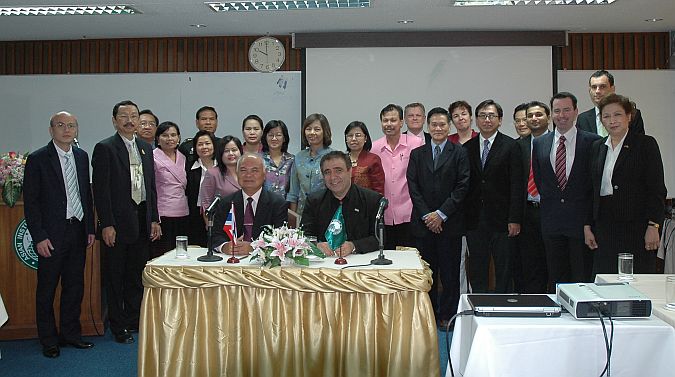Earlier this year, Nakhon Nayok was designated by the Royal Thai
Government to be the pilot province for the country’s Smart Thailand
strategy, which aims to use advanced information and communications
technology (ICT) to improve citizens’ lives through convenient services
and more effective administration.
Signing a Memorandum of Understanding (MoU) on 26 June 2012 with AIT
President Prof. Said Irandoust, Nakhon Nayok Governor Dr. Surachai
Srisaracam said it was important for his province to utilize ICT to
achieve sustainable development, and he was happy to have the
contribution and involvement of AIT in the ambitious project.
“We need expertise from AIT, which has vast experience and excellent
research and development capabilities,” the governor told high-ranking
officials attending the MoU signing ceremony at the AIT campus in
Pathumthani province.
Key to the tie-up will be joint research and development collaboration
in food technology, food safety, aquaculture and fisheries, and ICT.
Nakhon Nayok will also welcome AIT graduate students to undertake their
research projects in the province.
“I would like to see many students visit or even stay in Nakhon Nayok
and work on various topics in smart community (work) as their theses,
such as in city planning, GIS-based information systems, security,
planning of green growth, ICT for agriculture, smart energy systems,
sensor city, and disaster management,” the governor said.
President Irandoust commended the province for its clear
vision of a sustainable future, calling the partnership “a
model for provincial government-university collaboration.”
As a driver for technology and skills development, the MoU emphasizes
capacity development support for provincial employees through short
courses and training, and Doctoral, Master’s and Diploma programs. It
will also enable professional exchanges and visits between faculty
members and administrative staff members, and joint workshops,
seminars, conferences, and exhibitions.
The project’s national and regional-level scalability is attractive to
AIT. Officials said the model developed in Nakhon Nayok will
be mainstreamed to provinces across the country, and could be used
in the AEC. “AIT can assist both the province and the country to
bring the concept outward to the region,” President Irandoust
said.
Dr. Surachai agreed. “AIT’s internationality is particularly important
for us because we would like to make this project not only for Thailand
but for the ASEAN community.”
The governor stated elements of the province’s ambition included
developing a ubiquitous information infrastructure for people to
access the internet and online provincial services. This would involve
establishing information platforms and tools such as documents
issuance, approval systems, and various provincial planning processes,
he said.
Overall, the project assumes an ambitious agenda of establishing
extensive Wi-Fi infrastructure, GIS-based administration systems,
one-stop government services, IT zones, and ICT for agriculture, health
care, and disaster monitoring and mitigation.
According to the governor, a high priority is also to establish a
number of green industries in the province. Officials hope to achieve
this by establishing an ICT education, research and development zone
through the allocation of land to entice universities, research
institutes and industry.
At the ceremony the governor thanked Dr. Kiyoshi Honda and Dr.
Masahiko Nagai for their work on projects in Nakorn Nayok in the fields
of Remote Sensing and Geographic Information Systems, and earlier
efforts to establish the partnership.
He noted the role of Ms. Rassarin Chinnachodteeranum, a 2007 AIT
graduate from the CSIM field of study, who is now the Coordinator
of Nakhon Nayok Smart Province. He also thanked Dr. Vilas
Nitivattananon, who now serves on one of the project’s committees for
urban planning.
A large delegation accompanied Governor Dr. Surachai Srisaracam at the
signing ceremony, which included the province’s Deputy Governor;
Chief Police; Director, Education Region; Director, Religious Affairs;
Chief Military Recruiting Officer; Representative of Ministry of
Tourism; Representative of Ministry of Agriculture; Representative of
Ministry of Human Resources Development; Representative of Ministry of
Transport; Representative of Ministry of Environment and Natural
Resources; Representative of Department of National Statistics;
Representative of Ministry of Energy; Representative of Ministry of
Commerce; Chief of Provincial Behavior Control Office; Representative
of Ministry of Labor; Representative of Ministry of Culture;
Representative of Ministry of Health; Representative of Ministry of
Industries; Chief of Construction Works and Urban Planning; Chief of
Provincial Administration Office; Chief of Disaster Prevention and
Alleviation Office; Rural Administration Officer; Provincial PR Chief;
Chief of Provincial Development Office; Representative from the Lands
Department; and Provincial Treasurer.


